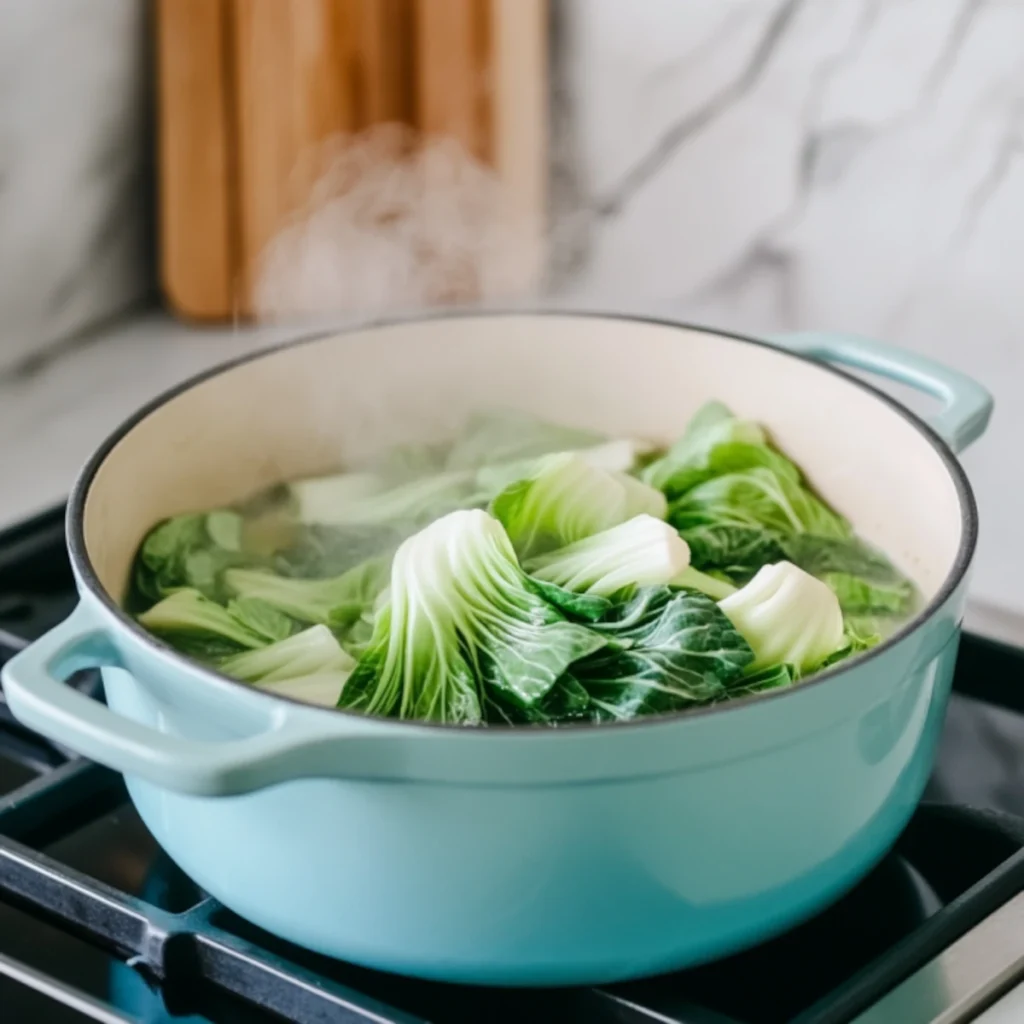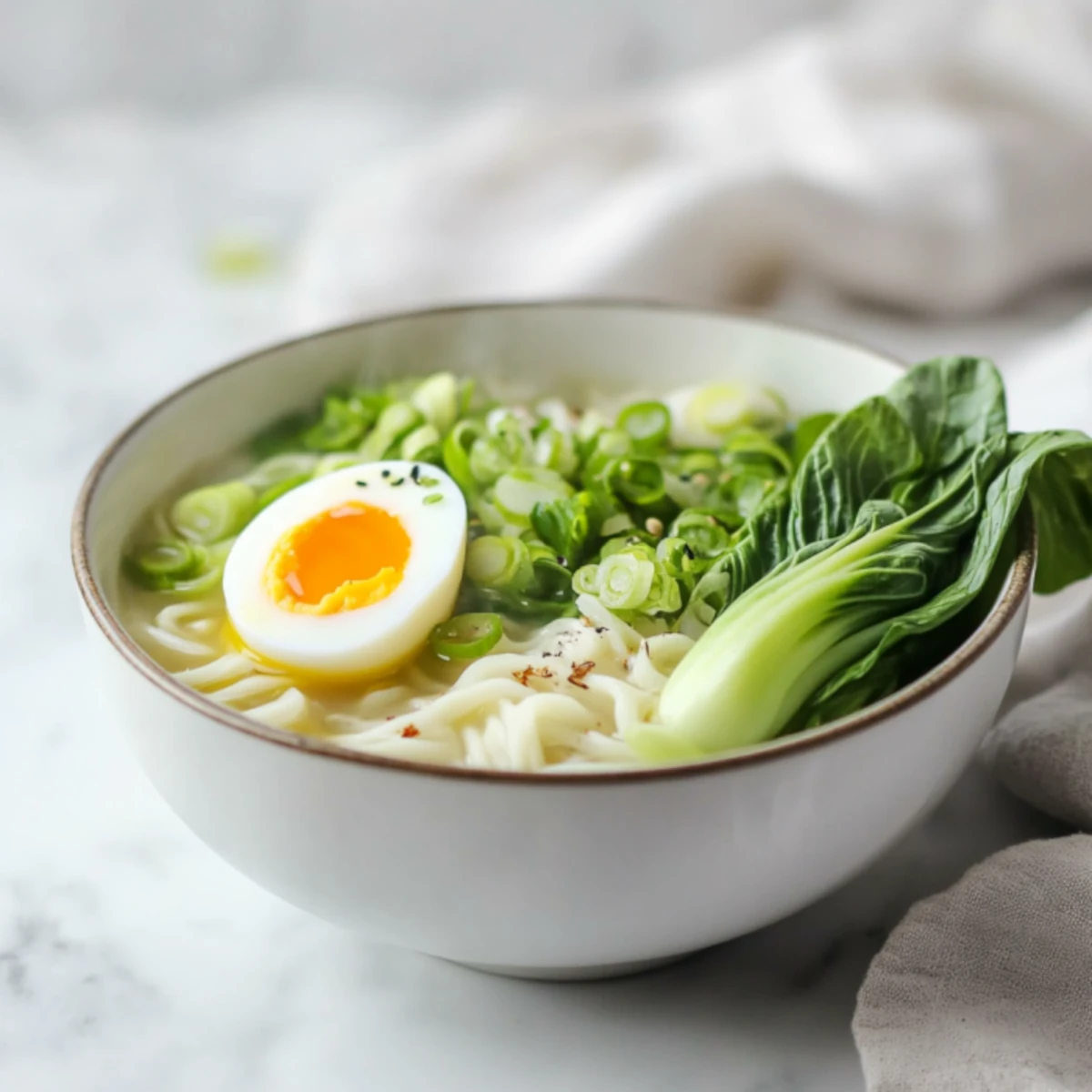Ramen is a symphony of texture, and bok choy plays the crisp, green note that keeps every spoonful lively. If you’ve ever paused mid-recipe wondering how to cook bok choy for ramen so it stays tender but not soggy, vibrant but not raw, you’re not alone. I’ve tested every method in my kitchen, from French-style steaming to quick stir-fries with a whisper of garlic.
And while bok choy isn’t a staple in traditional French cuisine, its elegance would feel right at home beside a velouté or tucked gently into a brothy bowl on a rainy day in Lyon.
Let’s cook it the oh là là way…
Prepping bok choy like a pro
Before getting to how to cook bok choy for ramen, let’s pause for the prep, because this green deserves more than a quick rinse and a chop. The better your prep, the better the bite.
Start with a good wash. Bok choy loves to hide a little grit where the stem meets the leaf, especially if it’s fresh from the market. Gently pull the stalks apart and rinse under cold water like you’re scrubbing leeks for a French potage, patiently, thoroughly, and with love.
Next, it’s all about the cut. Baby bok choy looks beautiful left whole or sliced lengthwise. It cooks quickly and holds its shape, which adds a touch of elegance to the bowl. Mature bok choy needs a bit more finesse. Separate the white stems from the leafy tops. Chop stems into bite-sized pieces and leave the greens loose. This gives you perfect control over texture when cooking.
Clean, cut, and ready to shine.

The top 5 methods for cooking bok choy for ramen
Think of bok choy as your ramen’s balancing act; freshness against richness, crunch against slurp. Each cooking method brings out something a little different, and choosing the right one can make your bowl feel light and bright or deep and toasty.
Here are the five best ways to cook bok choy for ramen, depending on the mood of your broth and the texture you crave.
1. Blanching: crisp, bright, and très clean
Drop stems into salted boiling water for 30–60 seconds, then add the greens or baby halves. Let cook just until bright green and barely tender. Transfer to an ice bath to lock in color and crunch. Drain well.
Why it works: Blanching preserves bok choy’s natural sweetness and keeps everything bright. Ideal for lighter ramen like shoyu or shio.
In your bowl: Add blanched bok choy just before ladling in hot broth, or skip the ice bath and let the heat of the broth finish the job.
2. Quick wilt in broth: simple and soulful
Bring your broth to a simmer. Add the chopped stems first and let cook for 30–60 seconds. Then add the leafy parts or baby bok choy and press them into the broth for another 15–30 seconds.
Why it works: This is the fastest and most integrated method. It subtly perfumes the broth while keeping the texture tender-crisp.
In your bowl: Use a slotted spoon to lift the bok choy into the bowl. Then layer in noodles and pour the broth over everything like a cozy pour-over.
3. Stir-frying: deep, toasty, très umami
In a hot skillet or wok, add oil and aromatics—minced garlic, a touch of ginger. Stir-fry stems first, 1–2 minutes. Add greens or baby bok choy halves and cook another 1–2 minutes. Finish with soy sauce, mirin, or a splash of broth.
Why it works: Adds a warm, caramelized note that holds its own in richer ramen like miso or tonkotsu.
In your bowl: Spoon stir-fried bok choy right on top of your noodles. The contrast is heavenly.
4. Roasting: smoky, golden, and unexpected
Halve baby bok choy or separate mature ones. Toss with oil, salt, and maybe garlic powder or chili flakes. Roast at 400°F (200°C) for 8–10 minutes for stems, then add leaves and roast 5–7 more minutes.
Why it works: This gives a slightly smoky flavor and crispy, charred edges; a bit like the lovechild of ramen and a Provençal gratin.
In your bowl: Use roasted bok choy as a final topping. It adds both elegance and intrigue.
5. Steaming: tender and pure
Steam halved or chopped bok choy in a steamer basket over simmering water. 3–5 minutes for tender baby bok choy, 5–8 for thick stems.
Why it works: Gentle and oil-free, this preserves bok choy’s subtle flavor. Perfect if your ramen broth already sings with complexity.
In your bowl: Add steamed bok choy just before the broth. Très clean, très chic.
Pro oh là là tips for cooking bok choy for ramen
To keep that perfect bite, treat bok choy the way the French treat their endives. Thoughtfully. Cook the stems and greens separately so nothing turns soggy. The stems should stay tender-crisp, and the leafy tops just wilted enough to melt into the bowl without losing their color or charm.
Now about pairings. Stir-fried bok choy adds depth to creamy miso ramen, while steamed bok choy brings a clean elegance to a light chicken broth. If it’s crunch you’re after, roasted bok choy adds texture and pairs beautifully with a soy-marinated soft-boiled egg, or even just a drizzle of sesame oil.
And timing? Crucial. Cook bok choy right before serving. It wilts fast, especially in hot broth. If you’re saving leftovers, store it separately from the soup and warm it gently to keep that fresh-from-the-stove feel.
FAQs about how to cook bok choy for ramen
What’s the best way to cook bok choy for ramen?
Blanching gives clean flavor and color, stir-frying adds depth, and quick-wilted bok choy blends seamlessly into broth. Choose based on your ramen style.
Do you cook bok choy before adding to ramen?
Yes. Cook it briefly before assembly using your chosen method, then add it to the bowl right before serving for perfect texture.
Should I use baby or regular bok choy?
Both work well. Baby bok choy is tender and pretty when halved. Regular bok choy gives more texture variety when stems and leaves are separated.
Can you add raw bok choy to ramen?
Technically yes, but it’s better lightly cooked. Raw bok choy can taste overly sharp and won’t soften properly in hot broth alone.
How do I stop bok choy from getting soggy?
Don’t overcook. Cook just before serving and avoid letting it sit in hot broth for too long. Drain well after blanching or steaming.
Let your ramen tell a story, of texture, balance, and a little green something that brings the whole bowl to life. Whether quick-wilted or delicately roasted, now you know how to cook bok choy for ramen with style.
Bon appétit!
***
Looking for more noodle nights with that same cozy slurp factor? Try these next:
Instant pot chicken and noodles: creamy, nostalgic, and ready in a flash
Mongolian ground beef noodles: sweet, savory, and perfect for busy weeknights
Garlic butter steak lightning noodles: rich, quick, and full of sizzle

